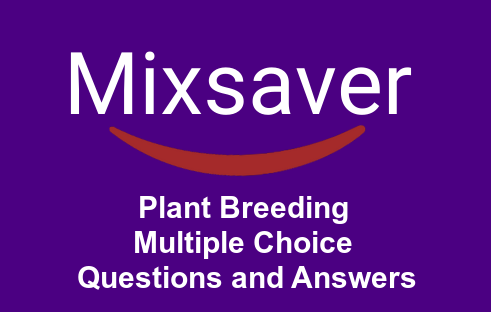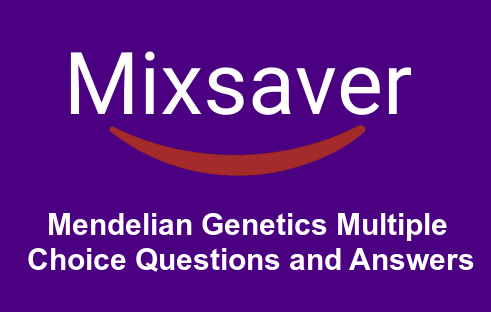MCQs on Plant Growth and Development
1. Apical dominance means
(a) suppression of growth of apical buds by the axillary buds
(b) suppression of growth of axillary buds by the presence of apical buds
(c) stimulation of a growth of apical buds by the removal of axillary buds
(d) inhibition of growth of axillary buds by the removal of axillary buds
Ans. b
2. Which of the following made pineapple to flower in off season?
(a) Zeatin
(b) Ethylene
(c) Temperature
(d) Short-days
Ans. d
3. Which one of the following hormone is involved in phototropism?
(a) IAA
(b) GA3
(c) Kinetin
(d) 2, 4-D
Ans. a
4. The synthetic hormone used as a weedicide is
(a) indole 3-acetic acid
(b) gibberellic acid
(c) 2.4-dichlorophenoxyacetic acid
(d) malic hydrazide
Ans. c
5. Induction of cell division and delay in senescence is done by
(a) cytokinin
(b) kinetin
(c) gibberellin
(d) auxin
Ans. a
6. Which one of the following is an agent orange?
(a) Weedicide with dioxin
(b) Chemical used in luminous paint
(c) Biodegradable insecticide
(d) Colour used in fluorescent lamp
Ans. a
7. A hormone used for inducing morphogenesis in plant tissue culture is
(a) abscisic acid
(b) gibberellins
(c) cytokinins
(d) ethylene
Ans. c
Plant Growth and Development class 11 NCERT
8. Highest concentration of auxin exists
(a) at the base of various plant organs
(b) in growing tips of plants
(c) in leaves
(d) in xylem and phloem cells only
Ans. b
9. Which of the following is the commercial use of auxin?
(a) Apical dominance
(b) Enhancement of RNA
(c) Root formation
(d) Protein synthesis
Ans. c
10. Which of the following is an auxin?
(a) Malic acid
(b) Abscisic acid
(c) Pyruvic acid
(d) Indole acetic acid
Ans. d
11. The plant substances which become inhibitory on accumulation are
(a) abscisic acid
(b) phenolic inhibitors
(c) auxins
(d) ?ytokinins
Ans. b
12. Which one is the test for gibberellin?
(a) Bolting in cabbage
(b) Morphogenesis in tobacco callus
(c) Rapid divisions in carrot cells
(d) Elongation of oat coleoptile
Ans. d
Plant Growth and Development NEET Questions
13. The phenomenon of growth is immediately followed by
(a) senescence
(b) differentiation
(c) development
(d) maturation
Ans. d
14. Vernalisation is applicable to plants like
(a) Chrysanthemum
(b) Eucalyptus
(c) Narcissus
(d) Gladiolus
Ans. a
NEET Questions on Plant Growth and Development
15. Dwarfness can be controlled by treating plants with
(a) cytokinin
(b) gibberellic acid
(c) auxin
(d) antigibberellin
Ans. b
16. Which one of the following growth regulator is used for rooting the leaves of Bryophyllum?
(a) IAA
(b) Gibberellic acid
(c) Carotene
(d) Lycopene
Ans. d
17. Indole-3-acetic acid, called auxin, was first isolated from
(a) human urine
(b) corn germ oil
(c) Fusarium
(d) Rhizopus
Ans. a
18. Sprouting of potato in storage can be prevented by
(a) malic hydrazide
(b) 2,4-D
(c) indole acetic acid
(d) naphthalene acetic acid
Ans. d
Plant Growth and Development NCERT
19. Which of the following physiological effect is caused by gibberellins in plants?
(a) Lengthening of internodes
(b) Maleness in plants
(c) Femaleness in plants
(d) Chloraphyll preservation
Ans. b
20. Growth inhibitor hormone is
(a) auxin
(b) abscisic acid
(c) gibberellin
(d) naphthalene acetic acid
Ans. b
21. Aplant hormone is
(a) an ion that alters turgor pressure
(b) a pigment that responds to environmental changes
(c) a chemical messenger that coordinates body cells
(d) a secondary metabolic compound
Ans. c
22. On the basis of excision experiments, it is concluded that the
(a) shoot gibberellins are derived from roots
(b) root gibberellins are derived from fruits
(c) root gibberellins are derived from shoot
(d) root and shoot gibberellins are derived frorm fruits
Ans. a
Objective Questions on Growth and Development
23. Abscisic acid is primarily synthesised in
(a) lysosomes
(b) Golgi complex
(c) chloroplast
(d) ribosornes
Ans. c
24. In tissue culture differentiation of root and shoot can be controlled by
(a) modifying auxin and cytokinin ratios in the medium
(b) using tissue of right size
(c) giving ternperature shocks
(d) change in light intensity
Ans. a
25. Who first suggested the presence of growth regulatory chemicals in plants?
(a) Went
(b) Sachs
(c) Darwin
(d) Paal
Ans. c
Plant Growth and Development NCERT pdf
26. Seed dormancy occurs due to the presence of
(a) ethylene
(b) abscisic acid
(c) IAA
(d) starch
Ans. b
27. Stimulation of cell division is concerned with
(a) cytokinin
(b) gibberellin
(c) auxin
(d) florigen
Ans. a
28. 2, 4-D stands for
(a) 2, 4-dimethyl phenoxy acetic acid
(b) 2-methyl-4-chlorophenoxy acetic acid
(c) 2-chloro-4 methyl phenoxy acetic acid
(d) 2,4-dichlorophenoxy acetic acid
Ans. d
29. Gibberellins causes
(a) curvature of coleoptile
(b) elongation of internodes
(c) initiation of lateral roots
(d) cell division
Ans. b
30. Increased availability of abscisic acid stimulates
(a) lipid formation
(b) protein formation in cell
(c) starch synthesis in guard cells
(d) cellulose synthesis
Ans. c
MCQs on Plant Growth and Development
31. Negative geotropism in horizontal stems is caused by
(a) accumulation of auxins on the lower side
(b) accumulation of auxins on the upper sirde
(c) cell shrinkage on the lower side
(d) cell enlargement on the upper side
Ans. a
22. Seedless fruits can be made by treating the unpollinated ovaries with
(a) auxins
(b) colchicine
(c) sucrose solution
(d) pure lanolin
Ans. a
33. Cut or excised leaves remain green for long if induced to root or dipped in
(a) gibberellins
(b) cytokinins
(c) auxins
(d) None of these
Ans. b
34. Which of the following phytohormone does not occur naturally in plants?
(a) 2, 4-D
(b) Gibberellic acid
(c) 6-furturyl amino purine
(d) IAA
Ans. a
Plant Growth and Development mcq pdf
35. Growth rhythms are set in a plant when it is exposed to
(a) CO, environment
(b) light
(c) low temperature
(d) UV radiation
Ans. b
36. Etiolation of plants is caused when they
(a) are grown in dark
(b) have mineral deficiency
(c) are grown in intense light
(d) are grown in blue light
Ans. a
37. In short-day plants, flowering is inhibited by
(a) interruption of dark by white or red light
(b) dark interruption by far-red light
(c) dark interruption red light followed by far-red light
(d) not possible gulatory
Ans. a
38. Bakanae disease is caused by
(a) fungus
(b) algae
(c) bacterium
(d) virus
Ans. a
39. Growth is a
(a) irreversible increase in size
(b) reversible increase in size
(c) reversible increase in shape
(d) increase in volume germinate in
Ans. a
40. The seed which possess the ability to suitable favourable condition is called
(a) quiescent
(b) viable
(c) dry
(d) dormant
Ans. b





